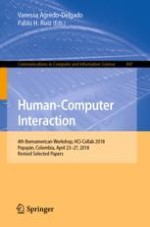2019 | Buch
Human-Computer Interaction
4th Iberoamerican Workshop, HCI-Collab 2018, Popayán, Colombia, April 23–27, 2018, Revised Selected Papers
herausgegeben von: Vanessa Agredo-Delgado, Pablo H. Ruiz
Verlag: Springer International Publishing
Buchreihe : Communications in Computer and Information Science
